If you have ever seen a car on the side of the road on fire, chances are it’s the result of improper fusing. Most car fires start through some sort of electrical issue that leads to the wire(s) getting hot and burning, catching other flammable materials on fire. Car audio and other add-ons to the vehicle’s electrical system are notoriously under-fused.
A properly sized electrical fuse can keep most of these situations from occuring in the first place. Don’t let your pride and joy burn to the ground because you didn’t use the right fuse.
Automotive electrical fuses are mechanical breakers that protect your vehicle’s electrical components and wiring in the event of a fault. Anything from a dead short (where the positive voltage shorts to ground) to a damaged component can cause an electrical fault. When this occurs, the power feeding the component must disconnect immediately. When a circuit’s amperage exceeds the fuse’s rating, the fuse metal heats up and melts. It is quite literally blowng up to protect the rest of circuit. Fuses are always installed on the positive side of the circuit in negative ground vehicles.
Most vehicles have one or two central fuse panels that provide the fusing for every circuit that requires one. If a circuit gets 12 volts, it needs a fuse. Low-voltage wires such as signal and trigger wires are typically not fused in most vehicles. Modern vehicles have hundreds of individual circuits, but similar circuits are often tied together to one main fuse. For example, most vehicles have one fuse for the radio, 12 volt ports, and sometimes courtesy lights.
If one of these circuits faults, then the fuse pops and you have to figure out which one caused the fault.
Fuse Types
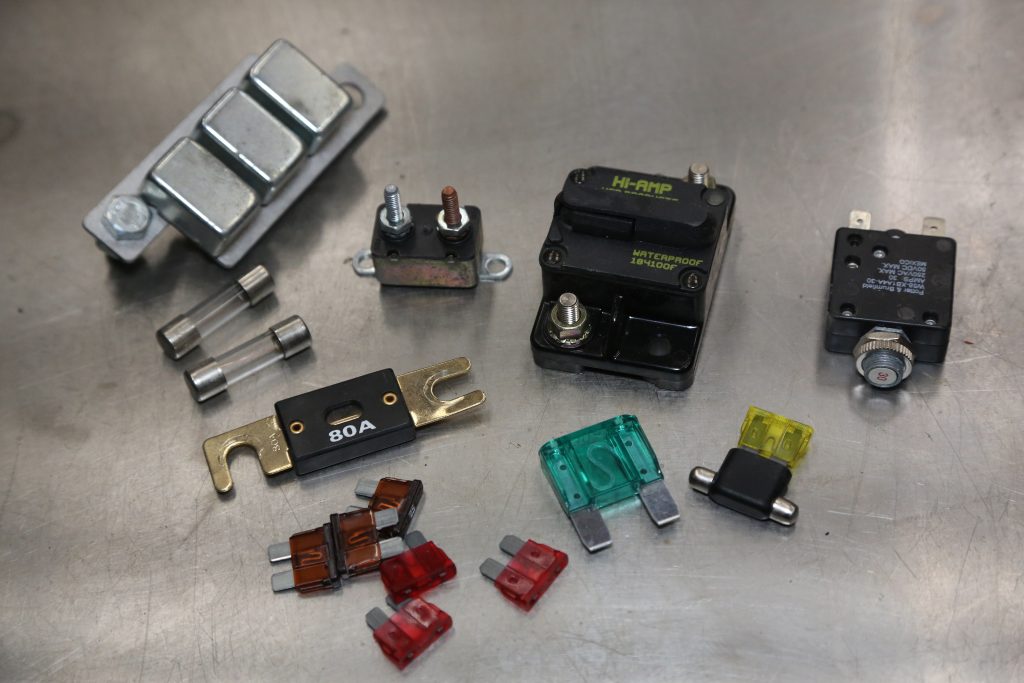
There are two types of fuses, sacrificial and resettable. Most OEM fusing is done with sacrificial fuses. Once the fuse metal in the fuse melts, it is trash and cannot be repaired. These are the most reliable and safest option for protecting electrical circuits.
Resettable circuits come in two flavors—manual and auto-reset. These are actually electromechanical circuit breakers rather than a “fuse.” When the circuit exceeds the amperage rating of the breaker, the internal components open the circuit.
Auto-reset breakers use a polymer that conducts electricity. As that polymer heats up with the increased current (amperage) draw, the resistance increases. Once a certain draw is reached, the polymer stops conducting. Once the polymer cools off, it will reset and start conducting again. There are also metal auto-reset breakers than use a thermal metal that acts like a spring. Once it heats up, it bends open to cut off the circuit. As the fuse metal cools, it snaps back in place and closes the circuit. If the fault is still present the breaker will just click back and forth, but your circuit is protected.
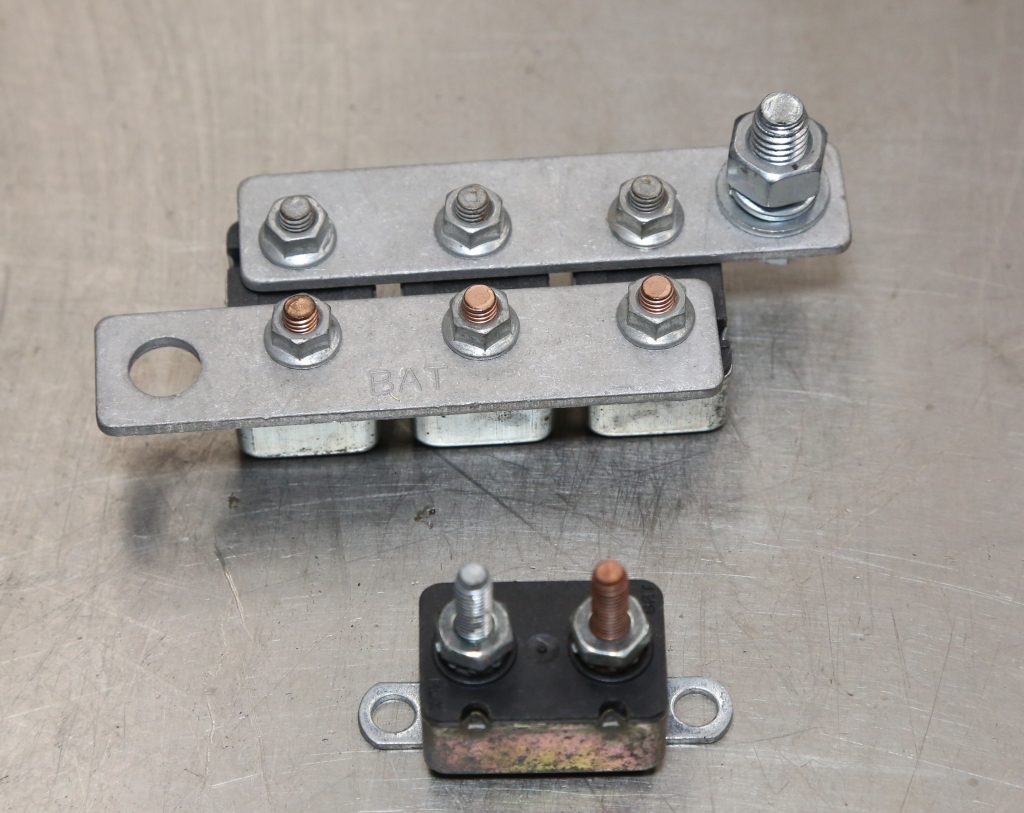
An auto-reset breaker is not a good idea for sensitive electronics such as ECMs, car audio, and navigation systems. The auto-reset function causes the equipment sees a reconnect regardless of whether the fault has been repaired.
It’s flipping your computer off and on over and over again, which can cause serious damage.
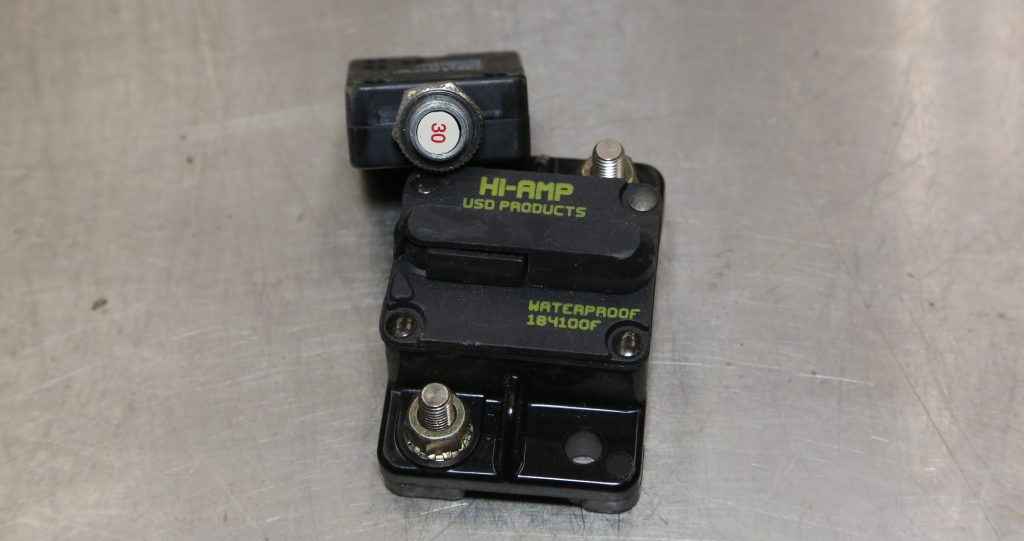
Manual reset fuses operate in the same manner as the metal auto-reset breaker, but instead of automatically closing once it cools, these breakers trip a spring loaded lever that has to be physically closed to reset the circuit.
This is what your house has in the breaker box.
Glass Fuses
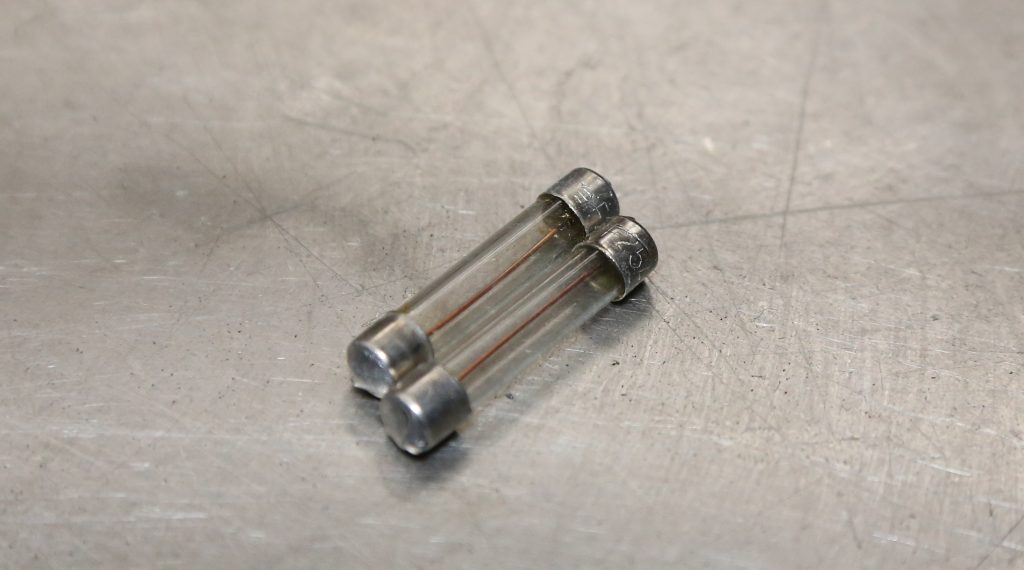
Glass fuses disappeared from most American-made vehicles around 1982. These fuses are rated for 32-volts DC with a range of 4 to 30 amps. There are numerous designs for automotive glass fuses. SFE and AG type fuses are fast-blow fuses—they pop as soon as there is more draw than they are rated for. Slow-burn fuses, like the MDL type, are timed fuses.
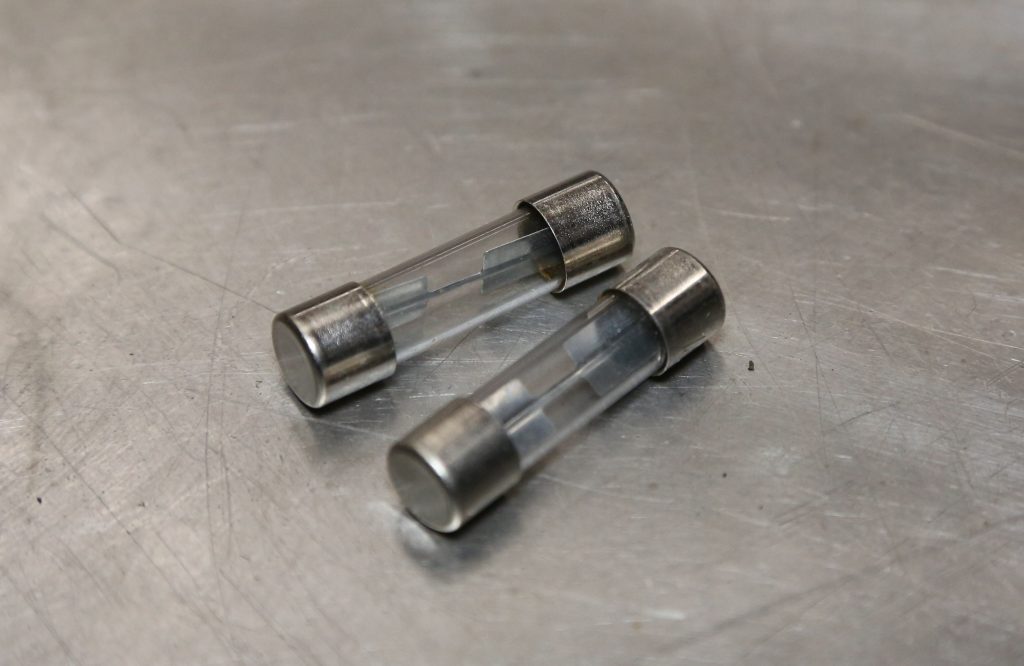
SFE Fuses are the original glass fuses for automotive use. SFE stands for Society of Fuse Engineers. The fuses are different lengths so that the wrong fuse cannot be installed into the wrong placement.
AG (Automotive Glass) Fuses have a suffix letter to denote the type:
- AGA- 1: 30 amps, 1/4” diameter x 5/8” long
- AGB: 0.177” diameter x .588” long
- AGC: 0.125 amps to 50 amps, 1/4 diameter x 1-1/4” long
- AGS: 9/32” diameter x 1-1/4” long
- AGU: 1 to 60 amps, 13/32 diameter x 1-1/2” long. These are also known as Midget fuses
- AGW: 1 to 30 amps, 1/4” diameter x 7/8” long
- AGX: 1 to 30 amps, 1/4” diameter x 1” long
- AGY: 50 amps only,1/4” diameter x 1-7/16” long
- UK: 35 to 50 amps, 1/4”diameter x 1-1/4” long
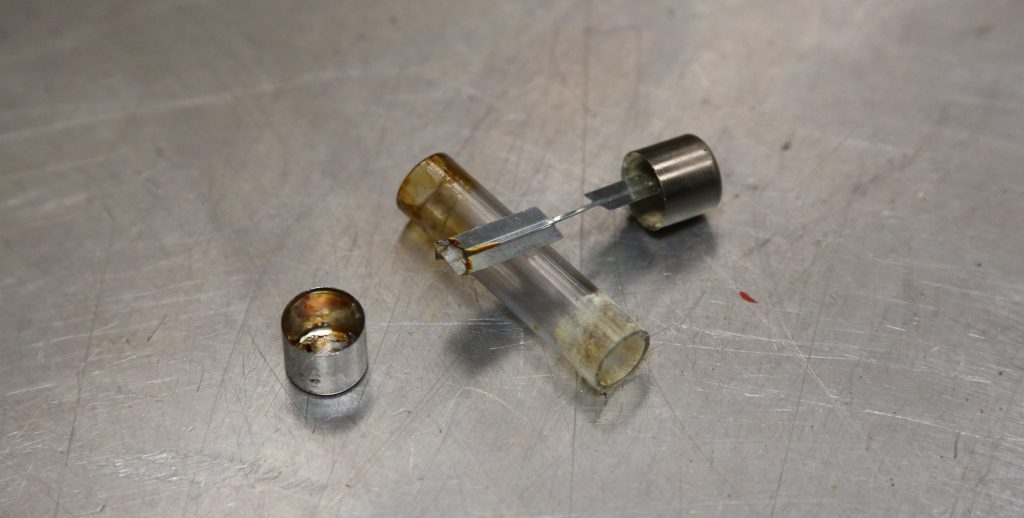
MDL Fuses are similar to AGC fuses in size and rating. Where an AGC fuse is a “fast blow”, meaning they pop instantly, MDL fuses are time-delay fuses that burn slowly. This allows the MDL fuse to resist higher amperages for very brief moments on a high-draw circuit such as an audio amplifier or electric fan.
Barrel (Non-Glass) Fuses
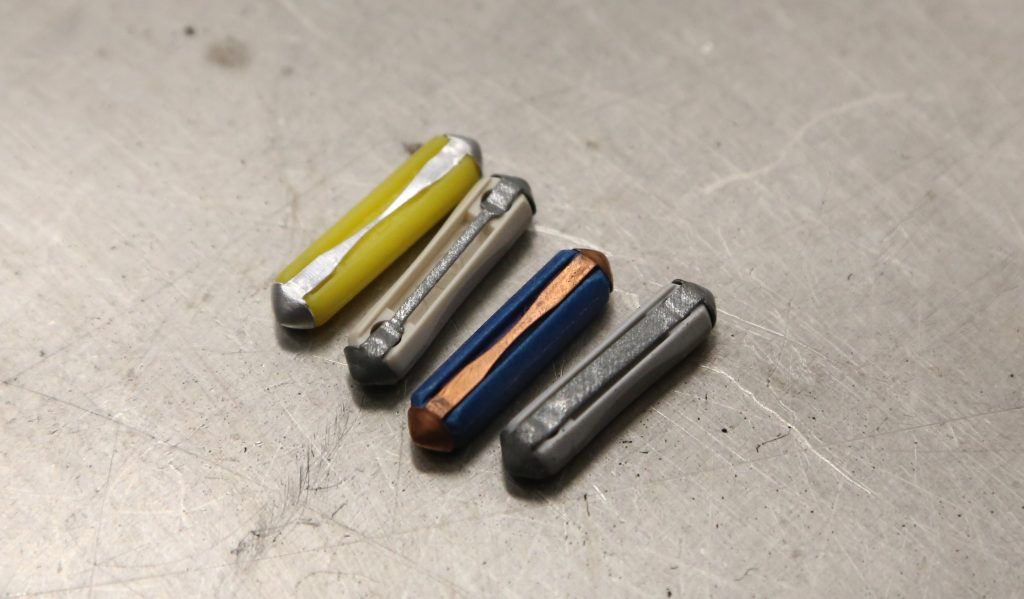
Used in older European vehicles, these plastic or ceramic barrel fuses have exposed metal fuse link. They install similar to a AA-type battery between two flat springs. These fuses are color-coded; sometimes the amperage is printed on the plastic, but originals usually are not marked for amperage.
- Yellow, 5 amps
- White, 8 amps
- Red\Green, 16 amps
- Blue, 25 amps
- Grey\Black, 40 amps
Lucas Fuses
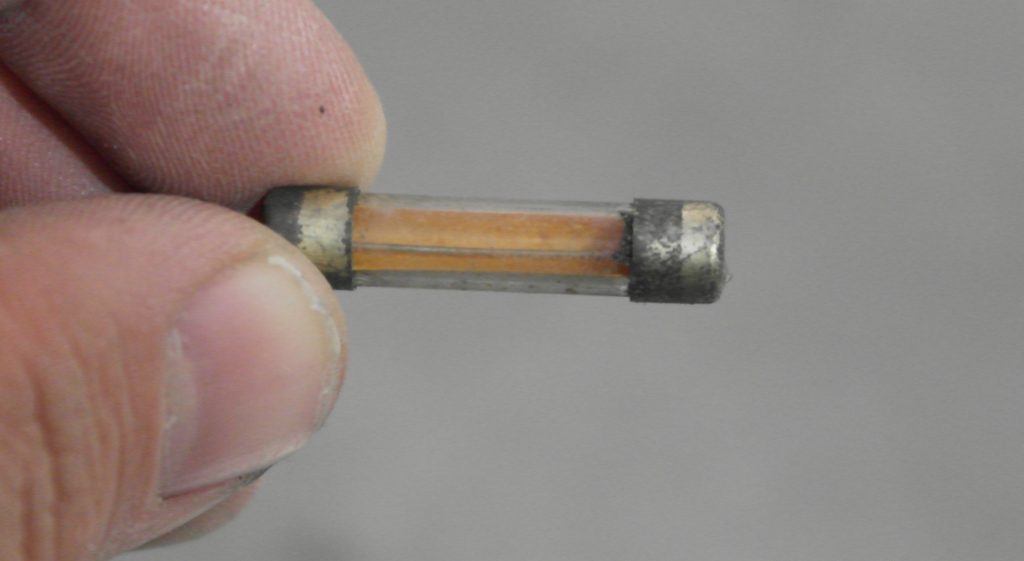
British vehicles suffer from a very bad reputation thanks to these fuses. The original Lucas fuses have a ceramic barrel that looks similar to a typical glass fuse, but you can’t see through them. The later style Lucas fuses have a glass barrel with a piece of paper inside that says “Lucas.”
When the fuse blows, the paper burns.
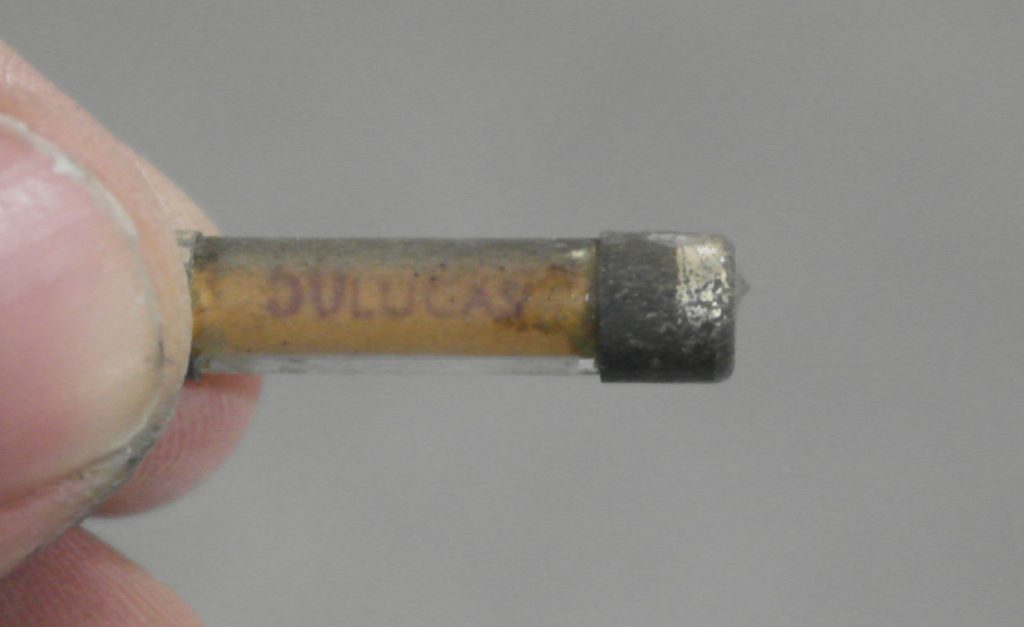
The rating system is awful. Lucas fuses have three ratings—continuous, instant fusing, and continuous fusing. Confusing the “continuous fusing” rating (where the fuse pops) with the smaller rating of “continuous amps,” which is where fuse operates normally, is a major source of problems.
For example, you have a 4 amp circuit that needs a fuse. A Nut Brown fuse rated for 4 amps of continuous current would be the correct fuse as it will pop with 10 amps of instant fault, or 8 amps of continuous fault. These can be replaced with non-Lucas glass-type fuses, in which case you use the smallest rating for the new fuse.
Lucas Electrical Fuse Color Codes
| Color | Continuous Amps | Instantaneous Fusing Amps | Continuous Fusing Amps |
|---|---|---|---|
| Blue | 1.5 | 3.5 | 3 |
| Yellow | 2.25 | 5 | 4.5 |
| Red on Yellow | 2.5 | 6 | 5 |
| Green | 3 | 7 | 6 |
| Nut Brown | 4 | 10 | 8 |
| Red on Green | 5 | 12 | 10 |
| Green on Black | 5 | 12 | 10 |
| Red on Brown | 6 | 14 | 12 |
| Light Brown | 7.5 | 18 | 15 |
| Pink | 12.5 | 30 | 25 |
| White | 17.5 | 40 | 35 |
| Purple & Yellow | 25 | 60 | 50 |
| Yellow & Red | 30 | 75 | 60 |
Blade Type Fuses
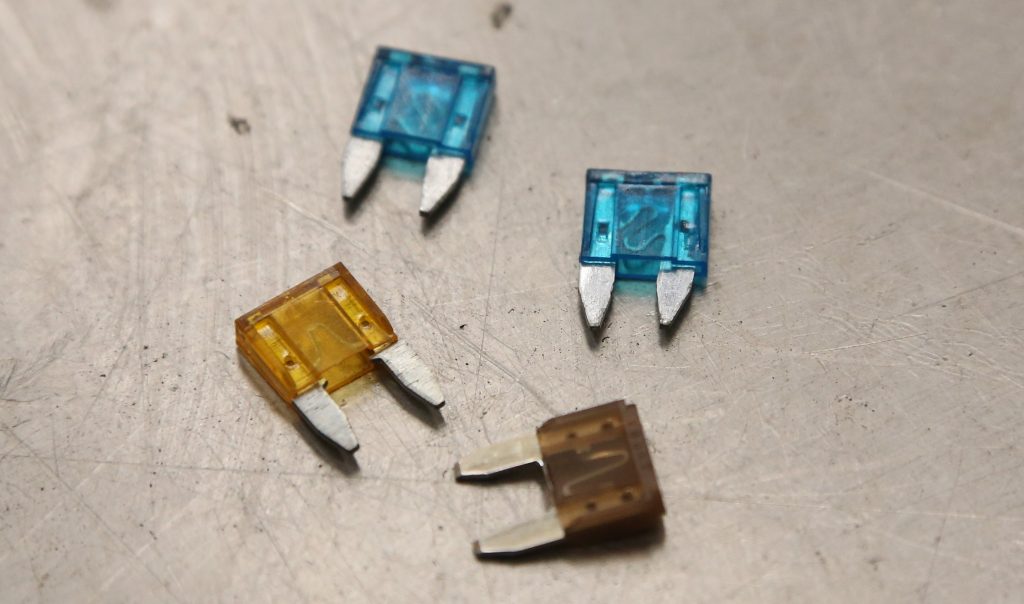
- Micro2: Also known as APT or ATR, these fuses are rated from 5 up to 30 amps
- Micro3: Also known as ATL, these fuses are rated from 5 to 15 amps
- LP-Mini/APS/ATT: Rated from 2 to 30 amps
- Mini/ATM/APM: Rated from 2 to 30 amps
- Standard/ATC/ATO/APR/ATS: Rated from 0.5 to 40 amps
- Maxi/APX: These much larger fuses are rated from 20 to 120 amps
Cartridge Fuses
These time-delayed fuses are generally used for higher voltage applications. Styles include MCASE 32V, JCASE low profile, and JCASE 32V. They range from 15 to 60 amps. These have become very common under the hood of modern vehicles. Cartridge fuses feature a square body that is color coded and the top is clear with the amperage printed on two sides.
High-Current Fuses
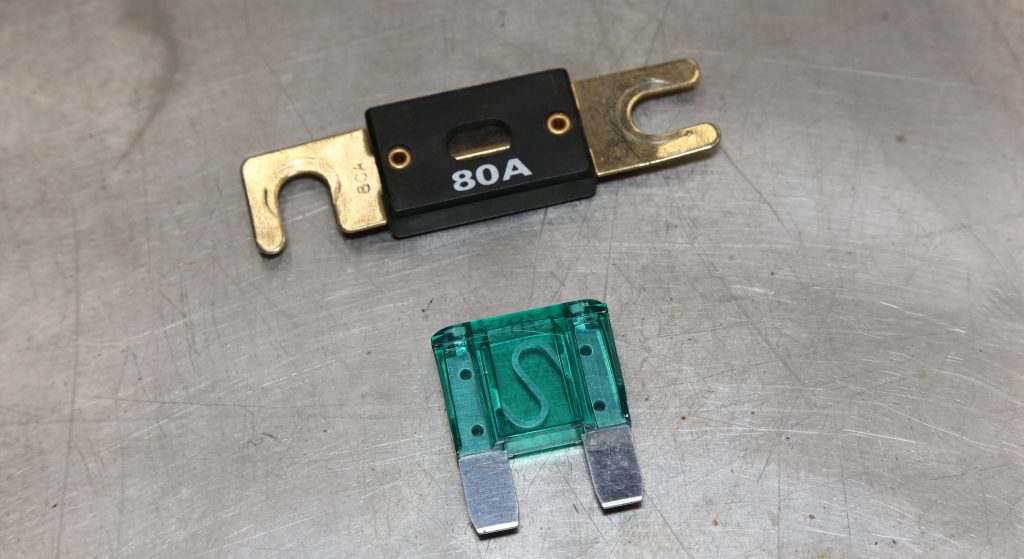
Large circuits need large fuses. In a modern vehicle, these are typically used for the main starter circuit and main body harness fuses. These fuses are large and mount with bolts or in some cases, large blades.
MEGA/AMG/BF2: current ratings from 60 to 275 amps, Used for starters, alternators, and batteries. They are a bolt-down fuse and are slow blow. These fuses measure 19mm x 68mm.
AMI/MIDI: These bolt-down fuses look just like MIDI fuses but are about half the size. Ratings range from 23 to 200 amps. These slow blow fuses measure 10mm x 41mm.
ANL: These fuses measure 20mm x 82mm and cover a range from 20 to 500 amps. Unlike the other bolt-down fuses, this design has slotted ends so the bolts do not have to come out completely.
MRBF/ZCASE: this is a single MEGA type fuse that is used for very high current applications, most commonly the starter. It is mounted with a single bolt. Fuse ratings range from 40 to 250 amps.
Class-T Fuses
Commonly used for EV and hybrid vehicles, the Class-T fuse is a high voltage fuse. These are available in amperage ratings from 10 to 50 amps, but the voltage capacity is much higher than 12 volts as the fuses are used specifically for the battery packs, which are in the 250 to 450 volt range.
Class-T fuses have the fastest blow speed of all high-current fuses.
Electrical Automotive Fuse Color Coding
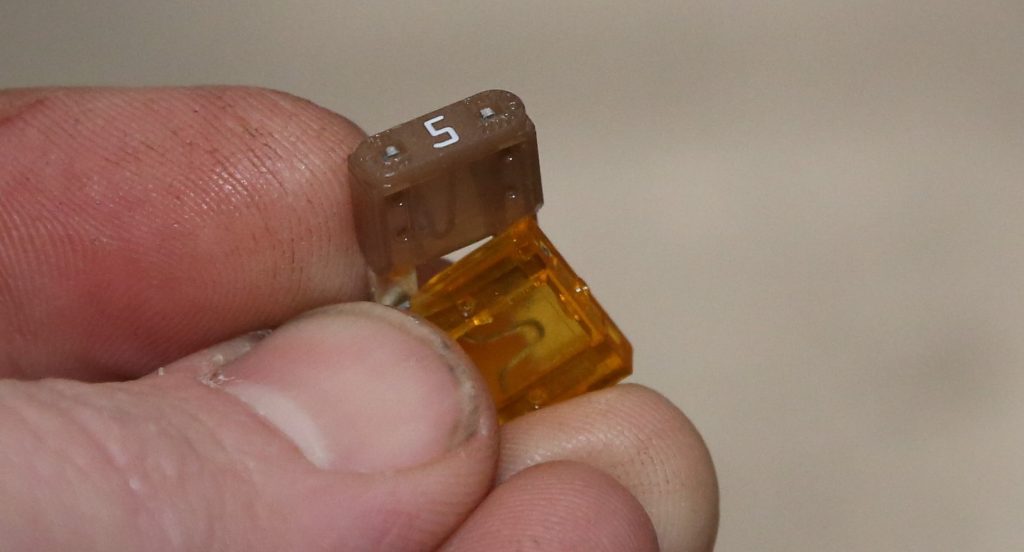
To tell these fuses apart, you can reference the virtual table below or CLICK HERE for a handy downloadable chart that has both the colors displayed and the color names spelled out. That way, you can use it regardless of whether you print it with a color printer or not.
Fuse Color Codes, by Amp
| Color | Amp Rating |
|---|---|
| Dark Blue | 0.5 |
| Black | 1 |
| Gray | 2 |
| Violet | 3 |
| Pink | 4 |
| Tan | 5 |
| Brown | 7-1⁄2 |
| Red | 10 |
| Blue | 15 |
| Yellow | 20 |
| Clear | 25 |
| Green | 30 |
| Aqua Blue | 35 |
| Orange | 40 |
| Red* | 50 |
| Blue* | 60 |
| Amber/Tan* | 70 |
| Clear* | 80 |
| Violet* | 100 |
| Purple* | 120 |
| * Some of the colors repeat. This is because all fuse types have limits; for example, MAXI fuses do not go below 20 amps and AGC fuses don’t go above 50 amps. | |
Did it Blow?
A sacrificial fuse is typically obvious when it has popped, but not always. These fuses have a fusible metal bar that melts, opening the circuit. If the fuse metal is melted, the fuse is bad. This does not always happen where you can see it. This is common for glass fuses. You can’t see the entire strip; the caps prevent it. The fuse metal is soldered to the cap; if the solder melts before the element you won’t see the break, but the circuit is dead anyway. This problem is very common for the large amperage glass AGU fuses.
You can test a fuse without removing it by using a digital multimeter set to continuity (where the unit beeps when the probes are touched together). Touch each lead to the ends or to the test terminals of the fuse. Your meter should beep (or read “0” if it is a silent meter). Any other reading means there is problem with the fuse and it should be replaced. You can also test a fused circuit using the 20v setting and probing each side of the fuse with one lead while the other lead is on a know good ground point.
You may appreciate this article too: How to Use a Multimeter for Troubleshooting Automotive Electrical Issues
Can I Use a Larger (Higher Amp) Fuse?
Typically, no. The fuses protect your vehicle’s equipment. If there is a fault, you need to fix the problem rather than just increase the fuse size. If you have a specific circuit that has been modified and has a higher amp draw, you can ONLY increase the fuse rating IF the wire that feeds the equipment is large enough to handle the increased amperage.
For example, your stock fuel pump has a 20 amp circuit with 12 gauge wire, but you swap in a larger pump that draws 30 amps. You cannot simply up the fuse size to 30 as the 12 gauge wire cannot handle it. You could use the 12 gauge wire to trigger a relay that has a 10 gauge wire (10 gauge has 30 amp rating) or upgrade the existing wire. Putting a larger fuse on the same circuit is a fire hazard. Headlight upgrades are a major source of automotive fires because upgraded headlight bulbs pull a lot more amps than the original halogen bulbs.
In short (a little electrical humor), fuses are your first and often last line of defense against electrical faults. You wouldn’t wire your breakers closed in your home’s breaker panel, so why take the exact same risk with your car?
***
Here are a pair of charts to help you calculate your wire gauge requirements in regard to the electrical component’s amp draw and length from your power source.
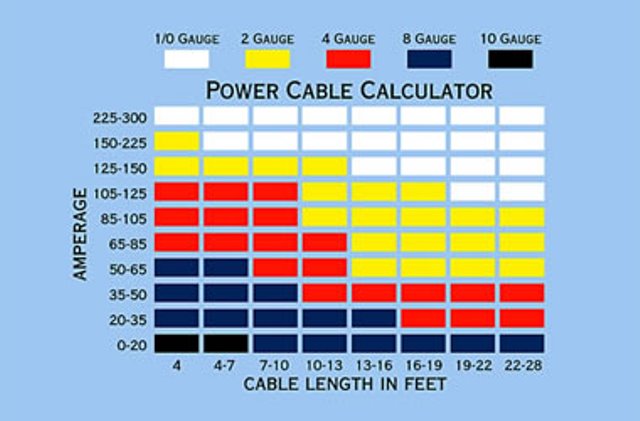
Wire Gauge to Wire Diameter Comparison Chart
| Wire Gauge (AWG) | Wire Diameter (Inches) |
|---|---|
| 4-0 | 0.460 |
| 3-0 | 0.409 |
| 2-0 | 0.364 |
| 0 | 0.329 |
| 1 | 0.289 |
| 6 | 0.162 |
| 8 | 0.128 |
| 10 | 0.101 |
| 12 | 0.081 |
| 14 | 0.064 |
| 16 | 0.050 |

Comments